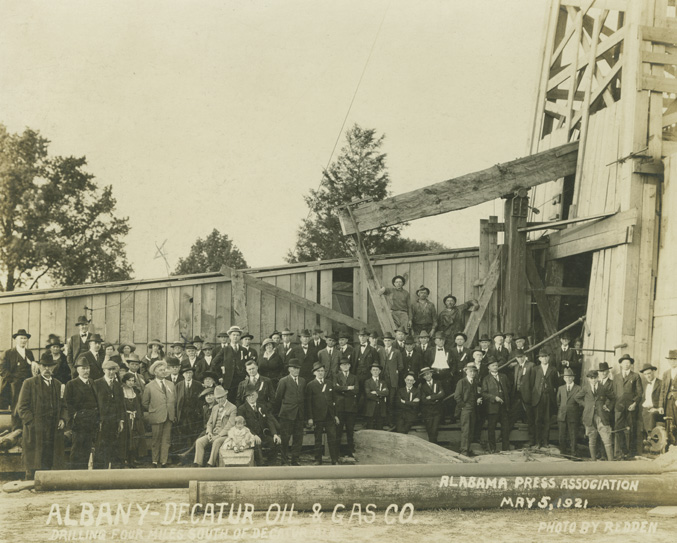Although what was known of Alabama’s petroleum geology did not encourage exploration, independent oil companies tried and failed for decades before commercial production began in 1944. Albany-Decatur Oil & Gas Company drilled its first exploratory well in Alabama on March 23, 1921.
The independendent exploration company’s No. 1 English well was spudded in suburban Decatur (Section 6, Township 6 South, Range 4 West), near where today stands a Walmart Supercenter. The company did not limit its speculation to Alabama, but quickly expanded with plans for a second well near Mulberry, Tennessee.

This May 5, 1921, photo shows members of the Alabama Press Association during a visit to the Albany-Decatur Oil & Gas Company well “drilling four miles south of Decatur.
National Petroleum News reported, “In spite of of more or less discouraging governmental geological reports and in the face of a financial depression which makes new financing difficult, the Albany-Decatur Oil & Gas Company with headquarters in Decatur, Alabama, is proceeding with a stock selling campaign and in the meantime drilling a test in the wildest of wildcat territory in middle Tennessee.”
The company’s distant gamble was on a site in Lincoln County near Mulberry, about 13 miles from a railroad in Fayetteville.
By September 1921, Albany-Decatur Oil & Gas Company’s rank wildcat well (far from any successful well), the Robert T. Moore No. 1, reached a depth of about 750 feet using a “grasshopper rig” – an inexpensive and rudimentary derrick apparatus, less capable than a standard cable-tool rig, but better than a springpole (see Making Hole – Drilling Technology).
“Persons in Fayetteville reasonably conversant with the company’s affairs state that the sale of stock is progressing, though slowly, and further state that the securities marketed are offered as shares in a speculative project which may or may not be profitable,” explained the National Petroleum News.
“To Lincoln county people they are selling ‘test for test’s sake’ inasmuch as the lease is 75 or 100 miles from production,” the publication added. “Besides, the shares sold carry an interest in the company’s other test being drilled with a standard rig near Decatur, Alabama. The literature circulated in Tennessee to promote stock sales is patently blatant, however.”
The terminology referred to highly exaggerated claims that lured unsuspecting investors – referred to as Blue Sky laws – which varied from state by state.
Meanwhile, back at the company’s other test well in Decatur, drilling on the No. 1 English well continued, but intermittently.
Albany-Decatur Oil & Gas Company’s Tennessee wildcat venture ended abruptly when the Robert T. Moore No. 1 encountered a common oil field hazard: “stuck tools.” All fishing efforts to clear the borehole of obstructions failed (learn more in Fishing in Petroleum Wells). The wildcat well was lost and abandoned.
Despite the failure, stock sales continued to fund drilling on the No. 1 English well, which had begun with an envisioned total depth of 1,500 feet. But finding no oil and financed by operating funds from stock sales, Albany-Decatur Oil & Gas continued drilling deeper. By December,1926, the No. 1 English well was the deepest oil well in North Alabama – reportedly reaching a depth of 4,130 feet.
And there the document trail ends. The Alabama Oil and Gas Board has no record of any oil or natural gas coming from the No. 1 English well: no permit Issued; no Information about plugging (Bulletin 50, P. 34-36 & Sr 15, P. 164-165 for Driller’s Log).
Alabama’s first oilfield would not be found until February 17, 1944, when independent producer H.L. Hunt, who had found great success in the earliest Arkansas oilfields of the 1920s and even greater success in the East Texas oilfield of 1930, discovered the Gilbertown oilfield. Prior to Hunt’s wildcat well, 350 dry holes had been drilled in the state.
___________________________________________________________________________________
The stories of many exploration companies trying to join petroleum booms (and avoid busts) can be found in an updated series of research in Is my Old Oil Stock worth Anything?
AOGHS.org welcomes sponsors to help us preserve petroleum history. Please support this energy education website with a contribution today. Contact bawells@aoghs.org for information on levels and types of available sponsorships. © 2018 AOGHS.

